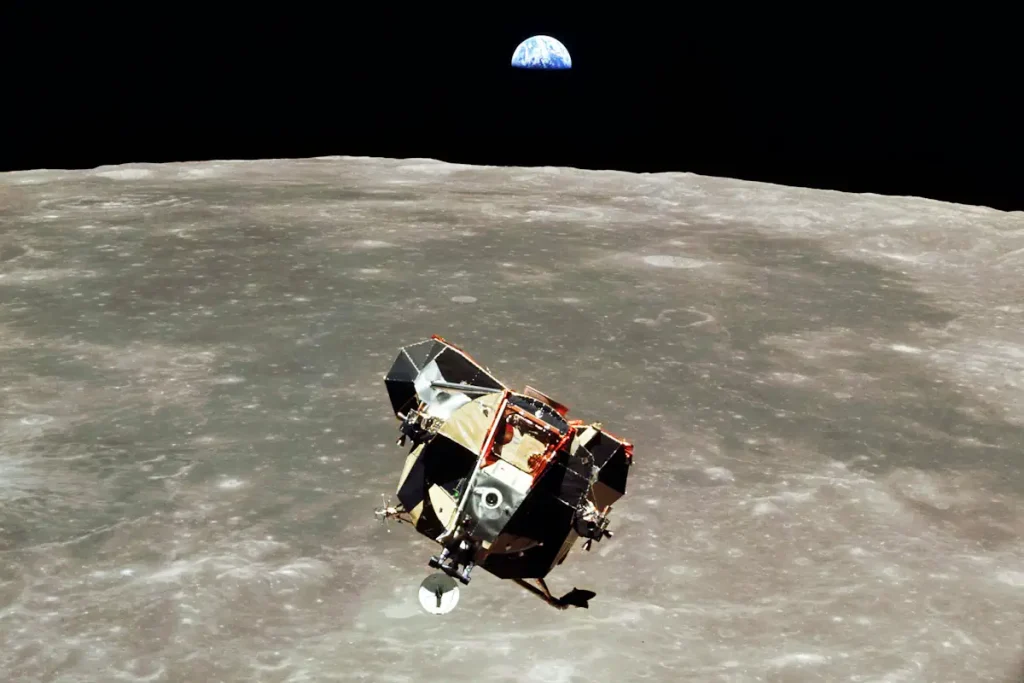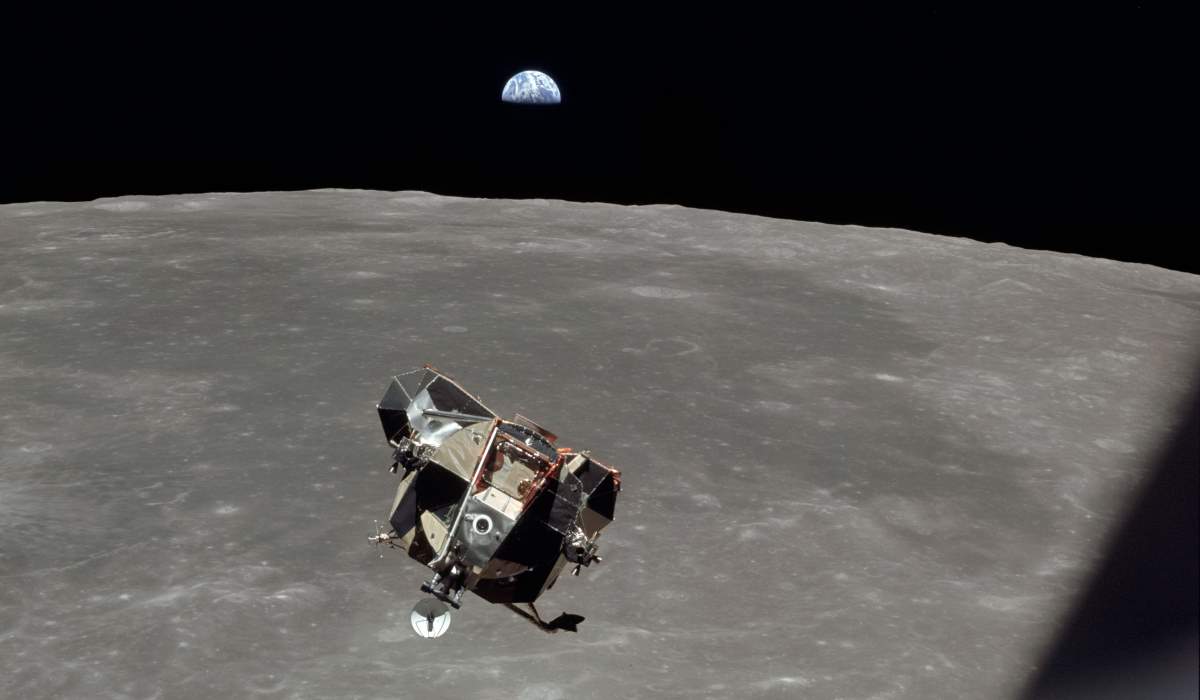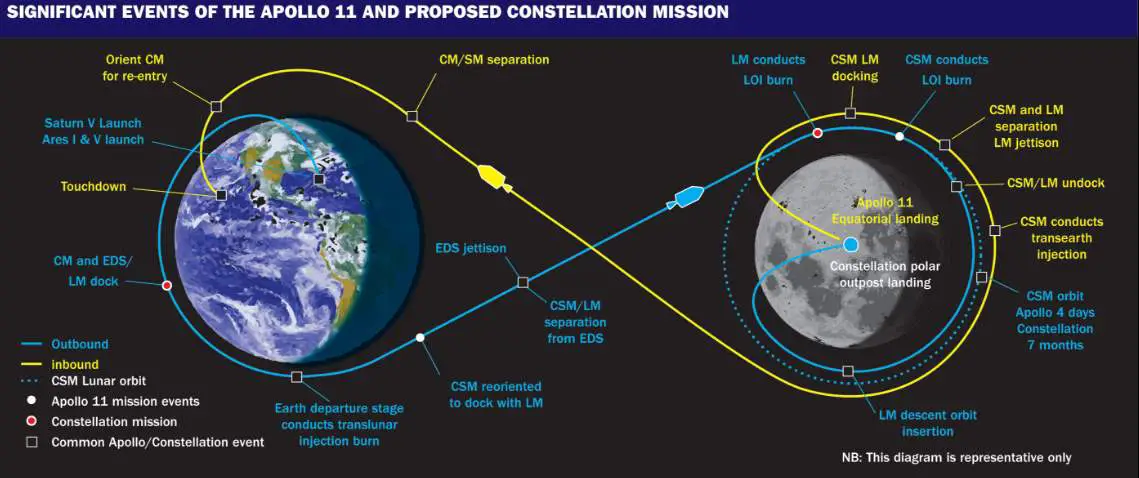In order to go to the moon, we use complex (and somewhat risky) Lunar Orbit Rendezvous. But, can’t we land a spacecraft on the moon directly? Wouldn’t it be easier? Here’s why we use Lunar Orbit Rendezvous instead of sending a spacecraft to directly land on the lunar surface.
The Lunar Orbit Rendezvous (LOR) and Its Significance in Space Exploration
In space exploration, the Lunar Orbit Rendezvous (LOR) holds a pivotal role in the accomplishment of crewed lunar missions. The LOR technique was employed in the Apollo moon missions to effectively solve the problems associated with propelling a heavy spacecraft out of Earth’s gravitational pull, landing it on the Moon, and returning it safely. This strategy also addressed the challenges related to fuel weight, spacecraft design, and mission safety.
The Lunar Orbit Rendezvous (LOR) is a complex maneuver wherein a main spacecraft (the command module) stays in orbit around the Moon, while a smaller, specialized vehicle (the lunar module) descends to the lunar surface. After lunar exploration, the lunar module then ascends from the lunar surface to rendezvous and dock with the command module in lunar orbit.
Rendezvous in Lunar Orbit
Lunar orbit rendezvous involves the precise coordination of two separate vehicles in space: the command module and the lunar module. After launch and journey toward the Moon, the Apollo spacecraft would slow down to enter a lunar orbit. The spacecraft consisted of two parts: the command module, which remained in lunar orbit during the lunar exploration, and the lunar module, which carried two of the three crewmen to the lunar surface.
Following the lunar exploration, the astronauts would take off in the ascent stage of the lunar module, rendezvous and dock with the command module, transfer back to the command module, and return to Earth, leaving the ascent stage in lunar orbit. Hence, the Lunar Orbit Rendezvous is a fundamental part of any crewed lunar mission.
Understanding Basic Concepts and Terminology
To fully comprehend the nature of Lunar Orbit Rendezvous, one must understand the basic concepts and terminology involved. For instance, the command module is in an orbit around the Moon while the lunar module is in a lower orbit. The angle resulting from drawing a line from the lunar module to the center of the moon and another line from the command module to the same point is called the ‘phase angle’. The altitude difference between the two orbits is referred to as the ‘height differential’. The phase angle and the height differential describe the relative positions of the command and lunar modules during the rendezvous – collectively termed the phase-height relationship.
The Rendezvous Plan
The rendezvous plan involves the lunar module’s path from the lunar surface to the command module in orbit. The command module maintains a known location in orbit relative to the lunar module on the Moon. When the phase angle is optimum, the ascent engine is ignited, and the ascent stage lifts off, using the descent stage as a launch pad. Once a safe coasting orbit has been achieved, the first planned maneuver, called ‘concentric sequence initiation’, is made to place the lunar module into a new elliptical orbit. At the highest point of this new orbit, the lunar module will be at a desired phase-height relationship below the command module.
Lunar Module Approach and Docking

During the rendezvous process, the lunar module and the command module will come into proper alignment. The third planned maneuver, known as ‘terminal phase initiation’, will lead to the intercept of the two spacecraft. From this point, the lunar module will approach the command module from below, an advantageous position for the final braking maneuvers. Once the lunar module is near enough, it will dock with the command module, and the crew members will transfer from the lunar module to the command module.
Why Not Land the Spacecraft Directly on the Moon?
The question often arises: why not simply land the entire spacecraft on the Moon? The answer lies in the complexities of space travel, particularly the issues of mass, fuel, and safety. Landing the entire spacecraft on the Moon would require a much larger vehicle capable of carrying the fuel needed for descent and ascent from the lunar surface, and the journey back to Earth. This would escalate the mission’s cost, complexity, and risk.
The decision not to land the entire spacecraft directly on the moon is a matter of practicality, economics, and safety.
First, let’s talk about the spacecraft’s weight. Sending anything into space is expensive, and a heavier object will require more fuel to launch, and hence incur a higher cost. The Apollo spacecraft was incredibly heavy, even by modern standards. It consisted of the Command Module (the cabin for the three-person crew), the Service Module (which contained propulsion, electrical power, and life support systems), and the Lunar Module (the vehicle that actually landed on the moon). The combined weight of all these modules was close to 50 tons.
Now, imagine if we decided to land the whole spacecraft on the moon. The moon’s gravity is about one-sixth that of Earth’s. To land this spacecraft on the moon and then launch it back into lunar orbit would require a substantial amount of fuel, significantly increasing the weight of the spacecraft, which would in turn demand even more fuel for launch. The additional fuel requirements would rapidly escalate, making the mission prohibitively expensive and technically challenging.
Moreover, landing the entire spacecraft on the lunar surface would have been a high-risk operation. A larger and heavier vehicle would be more difficult to control during descent and landing, thereby increasing the chance of a crash.

By using the Lunar Orbit Rendezvous strategy, NASA was able to save weight, reduce costs, and increase the overall safety of the mission. This strategy involved sending a single integrated spacecraft-the Apollo vehicle-into lunar orbit. The Lunar Module, a much smaller and lighter vehicle, would then detach and descend to the lunar surface. After lunar exploration, only the ascent stage of the Lunar Module would return to lunar orbit, leaving the descent stage behind. This significantly reduced the weight that needed to be launched back into lunar orbit and, consequently, the amount of fuel required.
Finally, the Lunar Orbit Rendezvous strategy allowed the Command Module to serve as a ‘lifeboat’ in case something went wrong with the Lunar Module (or vice versa). If the Lunar Module was unable to take off from the moon or achieve lunar orbit, the Command Module pilot could potentially come to the rescue.
The lifeboat role of the Apollo Lunar Module was exemplified in the Apollo 13 mission. An oxygen tank explosion in the Service Module forced the crew to abandon their original plan to land on the moon. Instead, they used the Lunar Module, “Aquarius,” as a makeshift lifeboat to provide life support and propulsion. This allowed the crew to perform a critical engine burn to return back to Earth, while the Command Module “Odyssey” was powered down to conserve its resources until reentry. Without the separate Lunar Module to serve this function, the crew likely would not have survived.
In conclusion, although the Lunar Orbit Rendezvous mission plan was complex and demanded intricate navigation and timing, it was the most practical choice. This strategy reduced costs, increased safety, and ultimately led to the success of the Apollo missions. Today, as we aim for Moon, Mars and beyond, the lessons from the Lunar Orbit Rendezvous continue to guide mission planning and vehicle design.
Conclusion
The Lunar Orbit Rendezvous is a sophisticated and critical strategy for executing successful crewed lunar missions. Its invention and implementation played a crucial role in enabling humans to land on the Moon and return safely to Earth. The complexities involved in this strategy, such as precise navigation, fuel management, and safety considerations, illustrate the tremendous ingenuity and effort put into human space exploration.
Lunar Orbit Rendezvous: A 1968 NASA Documentary
This 1968 NASA documentary titled “Lunar Orbit Rendezvous” was published by the Retro Space HD channel on YouTube.
Sources
- Lunar orbit rendezvous on Wikipedia
- “A Strategic Decision: Lunar Orbit Rendezvous” on the NASA website
- “NASA Decides on Lunar Orbit Rendezvous for Moon Landing” on the NASA History website
- “The Apollo Flight Journal: Lunar Orbit Rendezvous” on the NASA History website
- Budget of NASA, Year by Year [1980-1989] - June 10, 2024
- Budget of NASA, Year by Year [1970-1979] - June 10, 2024
- Budget of NASA, Year by Year [1958-2024] - June 10, 2024

